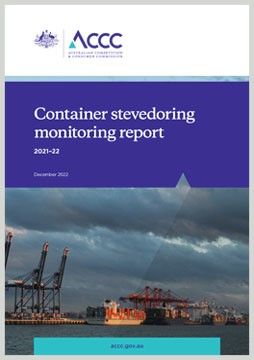At this time last year we brought you the Australian Competition and Consumer Commission (ACCC)’s annual Container Stevedoring Monitoring Report in which they warned Australia’s freight system was “in crisis.” This week, the ACCC released their Container Stevedoring Monitoring Report 2021-22 which reveals Container terminal companies’ profit margins have soared since the start of the Covid-19 pandemic to levels not seen for around a decade.
The operating profit margin of Australia’s container stevedoring industry has increased by 14% since the start of the COVID-19 pandemic to the highest level observed since the Patrick and DP World duopoly ended about a decade ago, according to the 2022 report.
The report examines the prices, costs, and profits of stevedores at Australia’s international container ports, but also looks more broadly at the state of the container freight supply chain following the pandemic disruption of recent years.
It shows that the industry operating profit margin of Australia’s five stevedores was 24% in 2021-22, up from 10% in 2019-20.
Between 2000 and 2013, Patrick and DP World (Sydney, Melbourne, Fremantle and Brisbane), and the Adelaide container terminal collectively achieved operating profits of between 21 and 27%. However, in subsequent years, competition from Hutchison, VICT and other developments has led to reduced results.
The report says that, at a minimum, Australia’s privatised container ports (Brisbane, Sydney, Melbourne, Adelaide) should be subject to greater regulatory oversight.
The report also says that cargo owners in Australia need more protection against unreasonable detention fee practices, after the ACCC heard that some cargo owners paid significantly higher detention fees in 2021-22. Shipping lines charge detention fees to cargo owners for continuing to use containers beyond an agreed period, to incentivise their prompt return.
Cargo owners said that some shipping lines had levied detention fees on them for failing to return empty containers on time, even though the locations the shipping lines had directed the containers be returned to were full.
“Importers and exporters benefited from an injection of new competition at our largest ports several years ago, but we’re concerned that in the past few years those gains have been eroded to the detriment of importers and exporters, and, ultimately, Australian consumers,” ACCC Commissioner Anna Brakey said.
She added: “If stevedores’ higher profits are due to the recent shocks to the global container freight supply chain, we’d expect their profits to decline over time as shipping and terminal congestion eases.”
The report explains that COVID-19 continued to cause significant congestion and delays in the container freight supply chain in the 2021-22 financial year, although global shipping schedule reliability has improved in the second half of this year.
Schedule reliability at Australia’s container ports is influenced by the reliability of global shipping schedules as congestion and delays overseas can delay arrival at other ports along a given route.
The ACCC is expecting to see margins fall as the circumstances that caused congestion and delays globally – and which also influenced rising Australian terminal handling costs and squeezed capacity, return to levels seen before the pandemic.
The Commission says it will be closely scrutinising the stevedores’ charges and financial performance in the coming years to see if there are any structural or behavioural factors sustaining higher profits, and whether any further policy or regulatory responses are warranted.
Talk to us here at Colless Young for logistics strategies and solutions. As licensed Customs Brokers and International Freight Forwarders, we offer professional service and advice on all your international trade and shipping requirements. Colless Young provides a complete range of import and export logistics services, both air and sea cargo, at all major Australian ports and airports. Call us for updated shipping schedules and freight rates.

